Welcome to FISH FOOD TIMES
Dec. 2017 issue No.168

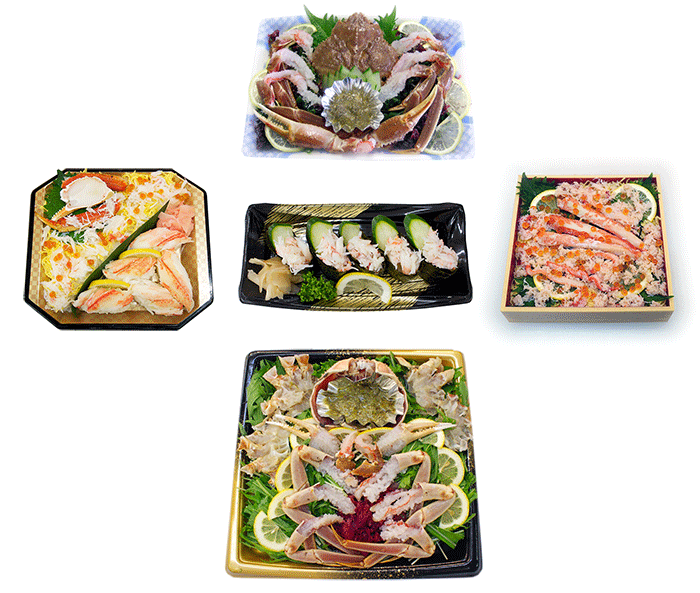
Value added products of snow crab
Soaring crab commodities
A year-end shopping battle came this year. One of the biggest selling items of the year is Crab lines of products such as king crab or the snow crab, which is the year-end sales battle in December. You may think that crabs usually exceed the sales amount for the next 11 months only in December's month, and December is just the biggest sales peak of crabs.
However, it is well understood that the crab commodity has continued to rise for the past several years, and the most surprising thing about this year's crab's price is "snow crab nail meat". This year, when I tried to purchase snow crab nail meat, the wholesaler sells it unless I give out about the same price as the selling price at the fish selling last year last year, so I was really surprised by this.
The reason for this rise is that Russia and the Japanese government, which accounts for more than half of Japanese crabs imports, signed the "Japan-Russia Agreement on Fishery and Smuggling Measures for Fishery Products" in 2014, It has been attributed to import crab imports becoming severer each time after year.
The reason for this agreement being concluded is that the total amount of Russian crabs circulating in the world's fisheries markets including the United States, Japan, South Korea, and so on, is far greater than the catch determined by the Russian government's law Because it turned out.
For example, according to the figure released by the World Nature Conservation Foundation Japan (WWF Japan), the public benefit foundation,
Illegal Russian Crab: An Investigation of Trade Flow(3.25MB)
The figure shows that there is a large gap between the amount of crab exported by Russia and the amount that Japan regards as importing, and this error is due to illegal poached fishing in Russian crab actually distributed It means that many things are included, and an agreement was signed to eliminate this poaching and smuggling.
With this agreement, the Russian government issued a certificate to the crab that was legally produced, and the Japanese side decided to accept only the crab with the certificate, and as a result, by the year that will be the third year, It is evaluated that it demonstrated.
However, this seems to be still insufficient, and according to the IUU (Illegal, Unreported, Unregulated) fishery, the Russian crabs imported to Japan in 2015 will be close to 25% of the total, these will be for North Korea and China It seems that means such as the existence of convenience holders (Belize, Honduras, Cambodia etc.) to detour, and transshipment to a ship at sea seems to be used.
Russian snow crab fishes are conducted in several waters such as Primorsky, Western Sakhalin, East Sakhalin, Magadan, West Bering and so on, the fishing seasons are also different and there are variations in quality, and the North Okhotsk fishing from May to June Crabs in the waters of Magadan seems to be the best quality.
Snow crab is caught not only in Russia but also in the United States (Alaska Bering Sea area) and Canada (the area around Newfoundland island) and imported to Japan, but especially in the Sea of Okhotsk, large size is caught It is said that there are features different from those of the area.
There are two kinds of snow crabs, Opilio and Bardai, with the following characteristics.
Opilio species; Many are caught from Canada to Russia, Japan, etc., there are three mountain beaks and the color of the eyes is orange. Flesh is thin and slightly watery.
Bulldai species; caught mainly in Russia and Canada. There are four mountains of beaks, the color of eyes is redish, the meat is strong and slightly hard, sweetness is not strong compared to Opilio. There are many thorns in the legs and the triangle of the shell is more flat than the Opilio. Opilio's large size is about the size of the small size of Bulldoi, Japan is captured in Hokkaido slightly.
The snow crab fished in Japan
Many snow crabs are acquired not only in Russia but also in Japan. The fishing season is decided by ministerial ordinance for the period of Matsubagani Japanese name (male) from November 6 to March 20 and the parent crab (female) from November 6 to January 10.
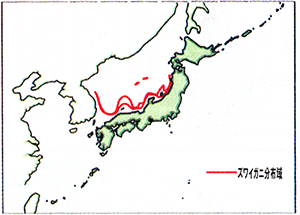
Matsubagani is the name of the male snow crab fish caught in Tottori prefecture, Hyogo prefecture, Kyoto prefecture San'in area, female is called "Oyagani" or "child having crab". It is the charm of the snow crab, which is solidly packed in meat, living in the depth of the continental shelf of the Sea of Japan from about 200 m to 400 m, and in the Sanin area (Sea of Japan) catch it with a bottomed net of a small ship. Crabs such as Japanese names Matsubagani and Echizengani are "snow crab (Opilio species)".
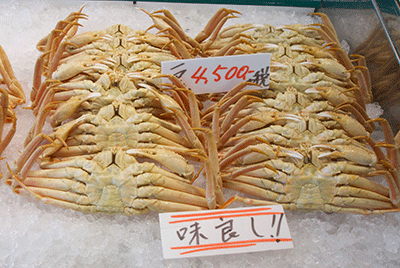
Matsubagani landing at the Taiza port in the Tango Peninsula in the northern part of Kyoto is called "Taizagani", and the female crab is called Koppegani. Tuiyamagani is a male snow crab brand name naught in Tuiyama port of Toyooka City in Hyogo ken north (Tajima district), locally calls male Jigani and female is Sekogani. Echizengani is the name of the male snow crab, which was taken to the main port on the Echizen coast such as Echizen Port and Mikuni Port, and the female is called Seikogani. Kanougani is the brand name of the male snow crab, which was landing at the fishing port of Kaga, Noto, in Ishikawa Prefecture, including the Hashidate fishing port, and female snow crab was brand name "Koubakogani". These region names are summarized as shown in the table below.
| Regional name of snow crab | ||
|---|---|---|
| Regional | male | female |
| Sanin area (Tottori, Shimane, Hyogo) | Matsubagani | Oyagani |
| Tango peninsula in northern part of Kyoto | Taizagani | Koppegani |
| Hyogo ken North (Tajima district) | Jigani | Sekogani |
| Echizen Harbor at Echizen Coast Main Port, Mikuni Port | Echizengani | Seikogani |
| Kaga, Noto in Ishikawa Prefecture | Kanougani | Koubakogani |
Snow crab is different in body size between males and females, and females are almost always holding eggs, so treat male and female as separate items in the coastal areas to be landing. Since the female does not shed moles after the first egg laying, it grows only to half the size of the male. For expensive male, females are lined up in stores as affordable as the images below.
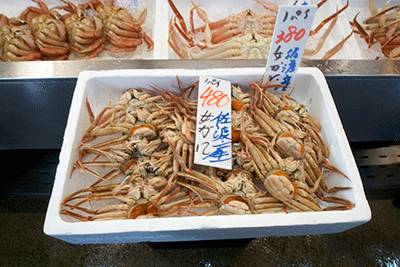
On the other hand, Deep red snow crab, which is very similar to snow crab, has a triangular shape with vermillion color from the time of raw, and when boiled it is more reddish than snow crab and taste is inferior to snow crab. It lives in a deep sea near the water depth of 500 to 2,500 m and is distributed from the northern part of the Japan Sea to the coast of the Pacific Ocean from San-in, Hokkaido to Choshi. The meat is a sweet and moist crab and it is necessary to preserve it with the shell down so that moisture will escape and be lost during storage and it is necessary to preserve it as the image below and the fish shop It is sold with the shell down. The fishing season of Deep red snow crab is from September 1 to June 30 in the autumn and spring, the fishery uses fishing gear with 150 crab baskets at 50 m intervals on the rope, submerging it to the ocean floor for about 2 day and night waiting for it to enter, the length of the fishing gear will be about 10,000 m.
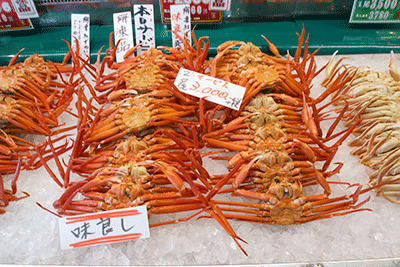
According to the fishery production statistics of the annual output by announced by the Fisheries Agency, the production and production volume of snow crab were estimated at 9,155 million yen (4,353 t) in Heisei 24, 10,035 million yen (4,181 t) in Heisei 25, 10, 503 million yen (4,348 t) in Heisei 26, 12,743 million yen (4,412 t) in Heisei 27. The catch volume does not fluctuate greatly, the catch is gradually increased, there is not much change. On the other hand, Deep red snow crab is 4,575 million yen (17,782 t) in Heisei 24, 4,256 million yen (17,389 t) in Heisei 25, 4,491 million yen (17,605 t) in Heisei 26, 5,148 million yen(16,899 t) in Heisei 27, and there is also a tendency that there is no big change both in the production amount and catch amount, and it is stable.
The snow crab is a designated fish species of TAC (Total Allowable Catch), and in 2004 the catch record of 4,134 t was reported to 4,723 t of the catch quota, and in the same way as before, the actual not reaching the catch quota is It is reported each year. From the environment surrounding the snow crab in Japan and the published figures it is clear that the fishing season and the limitation of catch for the protection of resources were successful and the snow crab of Japan achieved stable catch height and stable landing height It seems that it continues in a like manner.
In addition, although we call Male Shelled Soft and Softer, "Wakamatsubagani" or "Mizugani", in November this year, at the Japan Sea Snow Crab, Special Committee, Mizugani's fishing season we also decided to shorten it more than ever.
Crab circumstances in Korea and China
However, despite these efforts in Japan, the market price of crabs such as king crab and Hair queen crab as well as snow crab has tended to raise this year as a whole. As for why it is like this, it seems that China and South Korea 's strong willingness to buy is involved behind the market formation of imported snow crabs.
In this year's North Okhotsk area the Russian catch quota increased by 16% compared with the previous year but production seems to have been advanced mainly on live crabs for South Korea and China, Korea's Russian production from January to June the import amount of lives snow crab, which is 3,500 t, is 151% of the previous year, which is estimated to be 2,015 t, which is about three times higher than the previous year in China, production of the lives crab of the Sea of Okhotsk in the previous year It is predicted to grow from 5,000 tons to 8,000 tons. In other words, even though the production of snow crab increased, the number of lives snow crabs for Korea and China is large, and the price is pulling the market price, so the crab price in Japan has risen due to the narrow supply to Japan It is considered to be.
By the way, as for the method of selling the crabs in Korea and China, as far as the author visited the site, the selling method in the living state is basically felt as in the image below, almost all of the crab selling place in Korea and China I remember that it was a live fish tank.
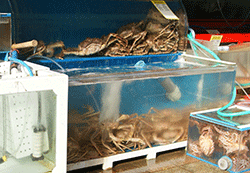
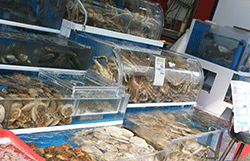
Busan Jagalchi Market
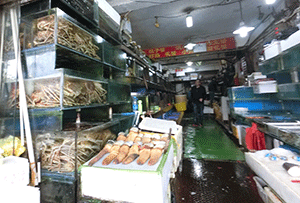
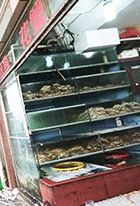
Shanghai Tongchuan Fisheries Market
Actual condition of crab sales in Japan
Well, as crab prices are soaring this year, it seems that Japanese fisheries officials are plagued with how to sell crabs.
As mentioned at the beginning, in the case of the crab production area, even if it is different, if you speak in a nationwide sense, crabs are overwhelming to exceed the selling price for the last 11 months only in December It is usual to sell at a momentum and customers seem to buy crabs only on special days of year-end and new year.
In other words, "crabs are consumption of large-scale behavior once a year", it seems that they do not care about differences in selling price of 100 yen or 200 yen. Probably the amount consumed by each household crab is decided in advance each year, and the customer should be feeling delicately whether the amount of crabs that can be purchased within that amount range is more or less this year. However, since it is once a year, it seems that there are many people who do not know much about the difference in size so much.
For example, in the case of a businessperson who is a sole proprietor whose income is likely to fluctuate greatly, the amount by which crabs can be purchased may be up or down depending on the profit of the year, but as long as the bonus does not change significantly It seems that there is not much that crab purchase budget fluctuates greatly.
In other words, unless you are a very rich or gourmet person, the crab is "a feast for a special day", so people who have decided to purchase crab items in the budget, whether high or low, It is presumed that it will be large, and dissatisfaction will increase even if the size of crabs which can be obtained with a large amount of thousands of yen as well becomes smaller every year.
As the end of the year comes closer, the customer is supposed to decide which shops are stocking what crabs and what price. So in December the shop should be prepared to be sure that customers are examining the level of the crab's assortment. Customers doing such actions do not assorte crabs for 11 months a year and in a store that will suddenly offer a few crabs in December, Do you think you would like to make a purchase? Perhaps a person who is prepared for a reasonable amount of expenses for crabs can definitely assert that they will never purchase at such stores.
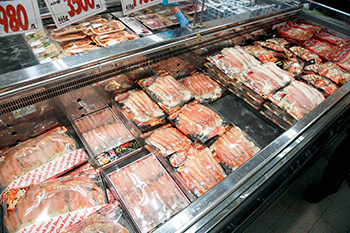
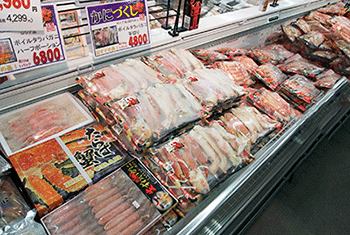
After all, the shop which the customer who chooses a large amount of money for crab is said that the product lineup of crabs is fulfilling enough as usual, and as the end of the year approaches, it secures wider crab sales area than any store It is a shop that makes an assortment of crab items of various sizes and prices from the upper rank to the lower range and further strives to expand the range of crab purchase choices. A shop where you can make big sales with crab products is a store that is keenly focused on the assortment of crabs from day to day so that people can purchase crabs.
Fish shop sushi can cover crab's loss
However, as a store's saying, "Crabs can not be easily sold, so I am afraid of loss due to price cuts or disposal," I think that there are many passive shops in crabs' assortment.
Certainly crabs are expensive and it is normal to not sell easily, so it may not be said that the excuse is wrong. However, there is no choice but to ask the fundamental question whether the seller of the store really is "making efforts to sell crab". For some reason, the person in charge of the store purchases the crab products manufactured by the manufacturer, simply puts a price seal and displays it in the freezing case, and still continues the posture waiting for selling later Is not it?
Thinking to sell crabs in such a comfortable business style itself, it can not be helped even if it is told that the posture is sweet. It seems that it is not selling because crabs are expensive but not selling from "they are not trying to sell crab firmly."
Let's introduce some examples of what crab sales efforts should be made.
What would you do if boil snow crab, which was selling in the frozen case of the following image, approached the expiration date without selling and later declined and sold only.
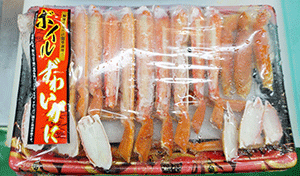 is
is 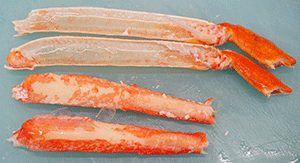 do this.
do this.
Furthermore, if snow crab nail meat is likely to remain,
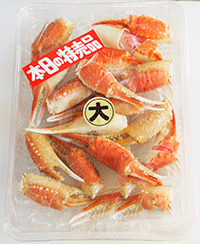 is from
is from 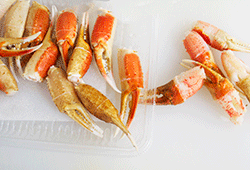 to
to 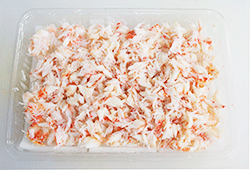
In this way, when these are combined with sushi rice,
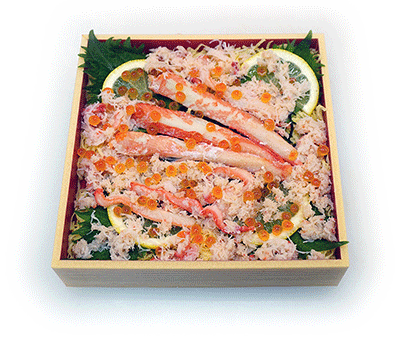
This "crab chirashi sushi" is completed.
Small legs of boiled snow crab and shoulder meat should be loosened small and used as a material of crab chirashi sushi together with crushed nail meat or it can be crab gunkansushi like the image below.
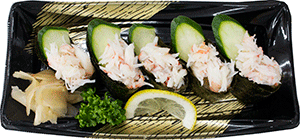
Furthermore, if the meat of a relatively large crab leg is kannonbiraki, it can be made into nigiri sushi as below.
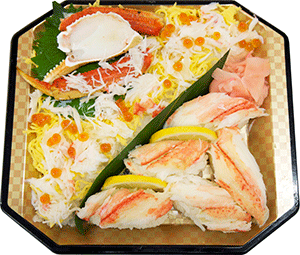
With the form of selling sushi at a fish shop in the fisheries department, we can actively work on assortment without worrying about the loss of expensive and difficult to sell crab products.
However, looking nationwide, there are not only companies that are ambitiously working on sushi at fishery in the fisheries department, there are still many super executives thinking that selling sushi items should be left to a delicatessen department It is really regrettable.
For the fisheries department dealing with fresh fish, the sushi products are very compatible, and for the fisheries department where sales growth is stagnant, the blank area with the largest remaining growth is 'fish shop sushi'. Since I think that super executives should be aware of the possibility that this sushi product group can drastically change the sales and profits of the fishery department fundamentally, I planning that I will mention a little about this in the 2018 New Year issue next month.
Sashimi of snow crab
By the way, how does the fish division of a company that does not have a means to change the crab into a fish shop sushi dispose of crab items that are about to expire? The conclusion is not that we only have to price down, there are several ways to change things such as vinegared things, but it is only for fish shop sushi to increase added price rather than putting out losses, I have no choice but to give up if I can not do it.
As a way to sell a little value added to the crab without changing it to sushi, it will probably make it "sashimi" again. The following are two kinds figure of sashimi.
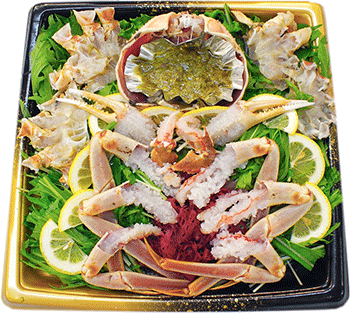
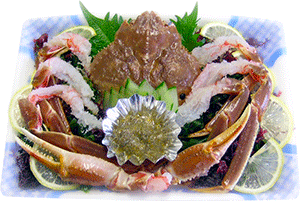
Both are raw snow crab and cook small live crabs as size. Remove the shells of the legs, put the body part in ice water for a while, take it for about 10 minutes and open it like a flower, take out the water. Basically the shell of snow crab should always be pointing down, though the image on the right is an exception. Because crab innards are particularly tasty on the shell of snow crab and crab innards flow out when the shell of the shell is facing upward.
It is this crab innards that is a point in this product. Crab innards is an organ called the hepatopancreas, which is a visceral organ of a crab which combines the functions of the liver that stores nutrients and the pancreas that produces digestive enzymes. Another name is also called "midgut gland" and contains a lot of nucleic acids such as fat and inosinic acid, so it has a rich and distinctive taste, but because it contains a lot of digestive enzymes, self digestion easily occurs and freshness deterioration is fast have features.
If the time since killing snow crab is clear, you can eat crab innards raw. But if you do not know how long it has passed since you killed snow crab, it is safe to eat through fire. The way to eat delicious crab innards is as follows, please refer it.
Make shell of the crab face down like a dish, collect crab innards there, cover the pan and steam it for about 30 minutes. When boiling it with boiling water the wateriness disappears and when crab innards solidify it will be at eating. Pour sake into the shell which finally finished eating "shell of the crab liquor", you can enjoy until the end of the crab innards.
To protect the food culture of fish · · ·
Well, let 's end this month. Did readers improve the knowledge of snow crab that I covered in this issue? Was it possible to get some information useful for assembling the business of year-end selling?
2017 will finally end this month, next month will have another new year, but I do not think that the topic of fish will never run out next year. However, it is also the true intention of the current Japanese that "fish food culture" can not show its presence as much as it used to, but it does not mean that he feels a bit of a sense of crisis.
A shocking remark that one president of a major supermarket said, "Sales of fresh fish division are steadily declining and it is no longer possible to show importance within the company as a whole, so we plan to shrink sales floor and personnel in the future" there were. Such a year may turn into a turning point that will occupy the future of the supermarket fishery sector.
If we assume that retailers with such a way of thinking will continue to gain momentum, there is something uneasy as to how the traditional food culture centered on Japanese ancient fish will go ahead. However, following such trends alone, existence of an extraordinary company that does not have the original "the ideal situation", conversely, "to support the Japanese food culture, by adhering to the true ideal situation Companies that survive "will be in the spotlight in the future in the opposite sense, but on the other hand, there is also a teacher company, so I'd like to think that I should do it.
I think that FISH FOOD TIMES would be able to continue to convey useful information as much as possible for the people who take care of the food culture of the fish.
An opinion and the communication are to iinfo@fish food times
Date of updating 1 Dec. 2017
